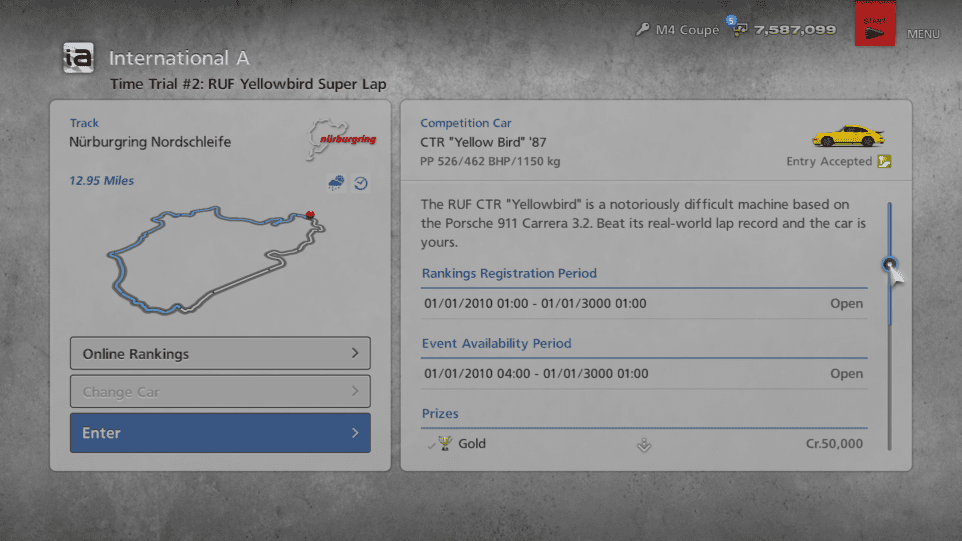- 2,169

- Sunderland
Not so far, although admittedly with AES discoveries I've pivoted more towards that. Hopefully there'll be time for everything.Any luck creating events with course maker tracks?
Not so far, although admittedly with AES discoveries I've pivoted more towards that. Hopefully there'll be time for everything.Any luck creating events with course maker tracks?


I'm not sure if it's possible to have them for different exhausts, but there's always the chance I'm just doing it wrong.Have you figured out how to assign different AES configurations / files to different exhaust parts? Including the manifolds and turbo conversions?
I've been saying this for literally years, a decade I think actually, but the potential of this system is off the charts. Just wait 'til you figure out how to get the most out of the ESGX mixing in conjunction with the AES exhausts
I can't remember how the sound allocation works to be honest. Different exhausts have different sounds, that much is obviously true. It's possible the samples are referenced differently from the AES files, since the only cars that use AES cannot be modified (in ways that would change the sound).I'm not sure if it's possible to have them for different exhausts, but there's always the chance I'm just doing it wrong.

Great to see you've got some knowledge of this stuff, W16 stuff would certainly be interesting but I think I'll wait until I've experimented more myself - right now I've only properly experimented with up to 10 cylinders and a tiny bit on a V12.I can't remember how the sound allocation works to be honest. Different exhausts have different sounds, that much is obviously true. It's possible the samples are referenced differently from the AES files, since the only cars that use AES cannot be modified (in ways that would change the sound).
My experience doesn't go very deep with all of this, I relied on more capable individuals. I do know my way around engine sound synthesis, though.
The sounds followed the engine in the case of "engine swaps", I seem to recall. So I'd say that would be a good place to look.
On that note, you should try a 350Z with one of the Red Bull V6 sounds. One of them, I can't remember which, is absolutely perfect for the job!
I also implore you to try a 5 cylinder sound.
Message me if you want any help with the signature sounds of certain engines / cars, e.g. I worked out how to do the W16
Firing order is one I’ve been paying close attention to but the inext and exext values are the ones that throw me off since I don’t really know what the abbreviations mean.Ah yes, I remember now. If you look in the AES files themselves, they also have entries for ESGX volume, or similar. That's the samples blended in at the same time, but the volume is usually set very low. Not sure if the specific sample set is also defined there as well.
I still think the engine definitions are the best place to look. Otherwise you're left with getting creative with the samples on top of AES and manually swapping out / modifying the sounds as and when.
Keep experimenting, it's a lot of fun! That 5 cylinder isn't far off, just a bit lumpy is all. The manifold ("extractor") numbers are too dissimilar. Also pay attention to the firing order. That is the key to the 350Z sound, and the differences in all the straight sixes. The system perfectly differentiates them all with the right numbers fed to it.
I found my old files so let me know if you get stuck!


Will try those on the 5cyl sound now, thanks. The main question I have is how do you know which manifold values correspond to good sound? For instance it's useful knowing that 20, 10, 10, 20, 0 is good for 5cyl, but why is that the case?For the five cylinder, try {20, 10, 10, 20, 0}. Assuming the crank angles just increase as {0, 144, 288, 432, 576}. No guesswork needed
Extractor is just another name for an exhaust manifold.
The intake channel is not operative, so ignore those numbers, unless you can get it working
EDIT: For the 350Z, try 57998
It pretty much depends on the engine configuration as it would in real life.Is the AES system capable of changing the idling? Like an engine with obviously altered timing.

Dark Souls mod for GT6 xDRe-enact Faszination at the Nurburgring (with all assists forced to off) and you might just bag yourself a CTR:


Yep, it’s just a simple “InDealer” value which is either 1 or 0. That’s how they hid the Lunar Rover and can be applied to any car.If it possible to add new cars, albeit using existing meshes, is it possible to hide cars from the dealership? I'd love to see all the dupes hidden.
